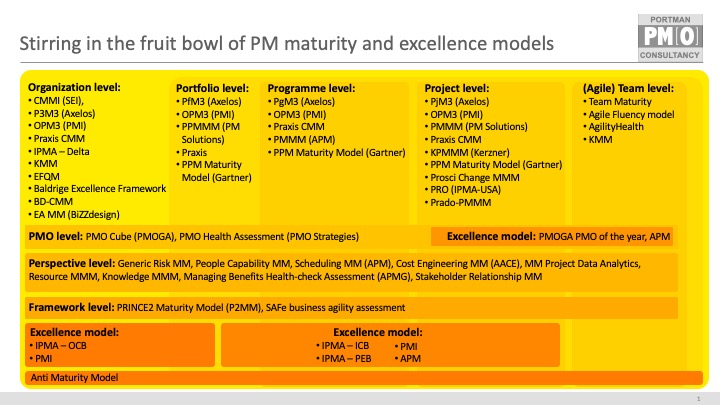Happy to see that the Project Management world Journal published my featured article Portman, H. (2022). Project management maturity and excellence models: Stirring in the fruit bowl; PM World Journal, Vol. XI, Issue II, February. In this article I look at different maturity and excellence models in project management. At this moment around 50 different models are included.
David L. Pells, Editor / Publisher PMWJ: “Five outstanding papers are included in the Featured Papers section. … And a late entry by Henny Portman in The Netherlands, “Project management maturity and excellence models: Stirring in the garden”, makes a significant contribution to the PM body of literature that should be read by every PMO leader worldwide.”
Why maturity models or excellence models?
The success rate of projects is still very low. If I look at the latest figures from the Standish Group (CHAOS 2020 – Beyond infinity) 60% or more, depending on your approach (agile or waterfall) is not successful. This is already for several decades the case!
To improve the way you are running projects, there are several paths to follow. You could look at the way your organization is doing projects. Or with other words how mature is your organization in doing projects? Some well-known maturity models are CMMI, OPM3, and P3M3. Another approach is to look at individual projects and ask how well this project was performed? Think about all those yearly contests that are running. E.g., the IPMA Global Project Excellence Awards, the PMO Global Awards, and the PMI Project Awards.
When you want to say something about maturity you have to look at the standards an organization has set and how they apply those standards to their projects. If one project is using the standards and another project uses a different or no standard this is a signal the organization isn’t mature in project management. You could even go further and compare the results found with industry average figures by using the same maturity model to understand your strengths and weaknesses compared with competitors. I also used maturity models to compare different business units within the same organization to find spots for improvement in one business unit and used ways of working of a better performing business unit in the same area. In this case you don’t need absolute figures, but relative ones will work too.
As an organization you could be less mature but still have an award-winning project. The award programmes are not maturity assessments!
To download the complete article Portman, H. (2022). Project management maturity and excellence models: Stirring in the fruit bowl; PM World Journal, Vol. XI, Issue II, February.

















Henny
Henny
Je artikel verschijnt in word bij downloaden, dus te wijzigen. Is dat bedoeling, moet dat niet PDF zijn?
Groet
Paul
Thanks for letting me know. Corrected
Pingback: An introduction to P3M3 - projectcubicle